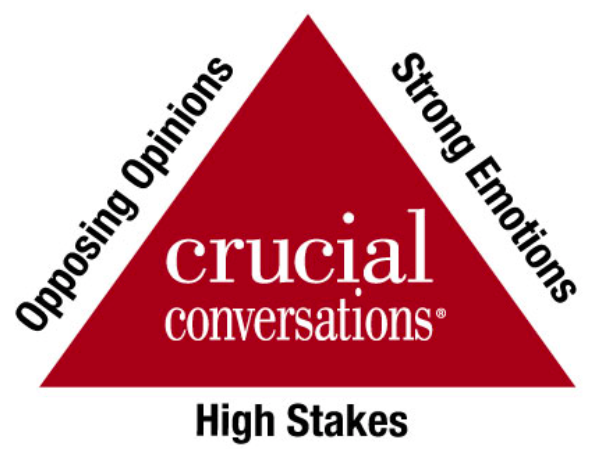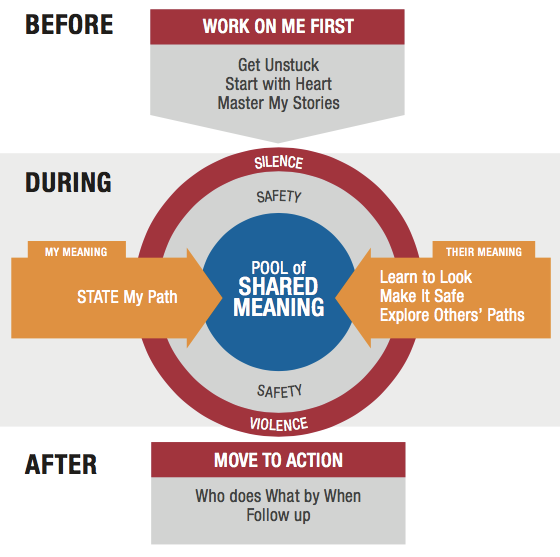Crucial conversations are defined as discussions between two people where stakes are high, opinions vary and emotions run strong. There are day-to-day occurrences that affect everyone’s lives - in many cases, there are pivotal conversations whose results may be extremely significant.
This book will teach us how to handle and even master of crucial conversations and by doing so change our lives.
What makes a conversation “crucial” vs. typical?
- First, opinions vary
- Second, the stakes are high
- Third, emotions run strong
How do we typically handle crucial conversations?
- We can avoid them.
- We can face them and handle them poorly.
- We can face them and handle them well.
Why don’t crucial conversations tend to go well?
- Emotions tend to rule
- Your body physically reacts
- We are under pressure
- We are stumped
- We act in self defeating ways
“Common” Crucial Conversations:
- Ending a relationship
- Asking a friend to repay a loan
- Giving the boss feedback about her behavior
- Critiquing a colleague’s work
- Asking a roommate to move out
Why it is important to master crucial conversation skills?
- Kick Start Your Career
- Improve Your Organization
- Improve Your Relationships
- Improve Your Personal Health
The free flow of meaning between two or more people.
Kevin spoke up. His words were simple enough—something like, “Hey Chris, can I check something out with you?” The reaction was stunning—everyone in the room stopped breathing. But Kevin ignored the apparent terror of his colleagues and plunged on ahead. In the next few minutes he in essence told the CEO that he appeared to be violating his own decision-making guidelines. He was subtly using his power to move the new offices to his hometown. Kevin continued to explain what he saw happening, and when he finished the first minutes of this delicate exchange, Chris was quiet for a moment. Then he nodded his head. “You’re absolutely right,” he finally concluded. “I have been trying to force my opinion on you. Let’s back up and try again.” This was a crucial conversation, and Kevin played no games whatsoever. He didn’t resort to silence like his colleagues, nor did he try to force his arguments on others. Somehow he managed to achieve absolute candor, but he did so in a way that showed deep respect for Chris. When he took a breath and opened his mouth, his overriding question was, “How can I be 100 percent honest with Chris, and at the same time be 100 percent respectful?
People who are skilled at dialogue do their best to make it safe for everyone to add their meaning to the shared pool—even ideas that at first glance appear controversial, wrong, or at odds with their own beliefs. Now, obviously, they don’t agree with every idea; they simply do their best to ensure that all ideas find their way into the open. As the Pool of Shared Meaning grows, it helps people in two ways. First, as individuals are exposed to more accurate and relevant information, they make better choices. In a very real sense, the Pool of Shared Meaning is a measure of a group’s IQ. The larger the shared pool, the smarter the decisions. And even though many people may be involved in a choice, when people openly and freely share ideas, the increased time investment is more than offset by the quality of the decision.
Crucial Conversations Model
Here’s how people who are skilled at dialogue stay focused on their goals—particularly when the going gets tough.
Work on Me First, Us Second:
- Remember that the only person you can directly control is yourself.
Focus on What You Really Want:
- When you find yourself moving toward silence or violence, stop and pay attention to your motives.
- Ask yourself: “What does my behavior tell me about what my motives are?”
- Then, clarify what you really want. Ask yourself: “What do I want for myself? For others? For the relationship?”
- And finally, ask: “How would I behave if this were what I really wanted?”
(How to stay in Dialogue when you’re angry, scared, or hurt)
Notice your behavior: If you find yourself moving away from dialogue, ask yourself what you’re really doing.
- Am I in some form of silence or violence?
Get in touch with your feelings: Learn to accurately identify the emotions behind your story.
- What emotions are encouraging me to act this way?
Analyze your stories: Question your conclusions and look for other possible explanations behind your story.
- What story is creating these emotions?
Get back to the facts: Separate fact from story by focusing on behavior.
- What evidence do I have to support this story?
Watch for Clever stories: We tell clever stories when we want self-justification more than results.
- Victim Stories – “it’s not my fault”
- Villain Stories – “it’s all your fault”
- Helpless Stories – “there’s nothing else I can do”
To turn victims into actors:
- What am I pretending not to notice about how I contribute to this problem?
- Am I minimizing my role while exaggerating the role of others?
To turn villains into humans:
- What would a reasonable, rational and decent person do this?
To turn the helpless into the able:
- What do I really want? For me? For others? For the relationship?
- What would I do right now if I really wanted these results?
- Learn to look at content and conditions.
- Look for when things become crucial.
- Learn to watch for safety problems.
- Look to see if others are moving toward silence or violence.
- Look for outbreaks of your Style Under Stress.
When others move to silence or violence, step out of the conversation and Make It Safe. When safety is restored, go back to the issue at hand and continue the dialogue.
Decide which condition of safety is at risk:
- Mutual Purpose: Do others believe you care about their goals in this conversation? Do they trust your motives?
- Mutual Respect: Do others believe you respect them?
Apologize when Appropriate:
- When you’ve clearly violated respect, apologize.
Contrast to fix misunderstanding:
- When others misunderstand either your purpose or you intent, use Contrasting. Start with what you don’t intend or mean. Then explain what you do intend or mean.
Create a Mutual Purpose:
- Commit to seek Mutual Purpose.
When you have a tough message to share, or when you are so convinced of your own rightness that you may push too hard, remember to STATE your path:
- Share your facts: Start with the latest controversial, most persuasive elements from your Path to Action.
- Tell your story: Explain what you’re beginning to conclude.
- Ask for others’ paths: Encourage others to share both their facts and their stories.
- Talk tentatively: State your story as a story—don’t disguise it as a fact.
- Encourage testing: Make it safe for others to express differing or even opposing views.
The Path to Action
(How to Listen When Others Blow Up or Clam Up)
To encourage the free flow of meaning and help others leave silence or violence behind, explore their Paths to Action. Start with an attitude of curiosity and patience. This helps restore safety.
Then, use four powerful listening skills to retrace the other person’s Path to Action to its origins.
- Ask: Start by simply expressing interest in the other person’s views.
- Mirror: Increase safety by respectfully acknowledging the emotions people appear to be feeling.
- Paraphrase: As others begin to share part of their story, restate what you’ve heard to show not just that you understand, but also that it’s safe for them to share what they’re thinking.
- Prime: If others continue to hold back, prime. Take your best guess at what they may be thinking and feeling.
(How to Turn Crucial Conversations into Actions and Results)
Turn your successful crucial conversations into great decisions and united action by avoiding the two traps of violated expectations and inaction.
- Command: Decisions are made without involving others.
- Consult: Input is gathered from the group and then a subset decides.
- Vote: An agreed-upon percentage swings the decision.
- Consensus: Everyone comes to an agreement and then supports the final decision.
Determine who does what by when. Make the deliverables crystal clear. Set a follow-up time. Record the commitments and then follow up. Finally, hold people accountable to their promises.


